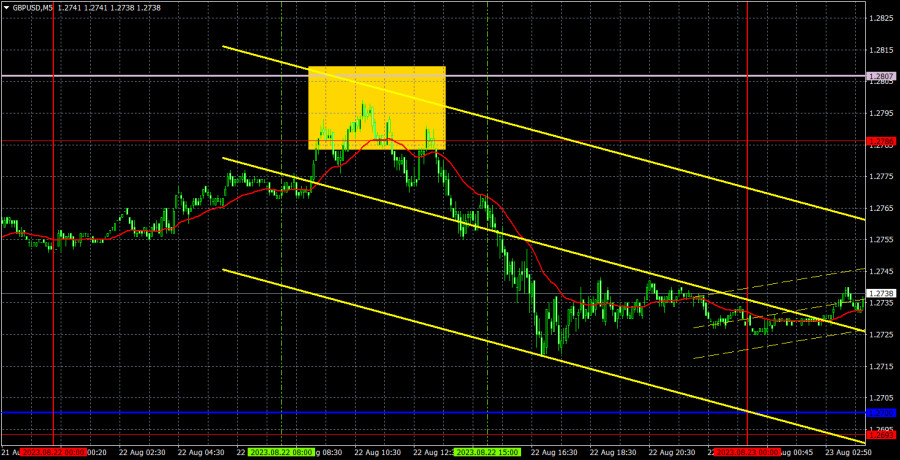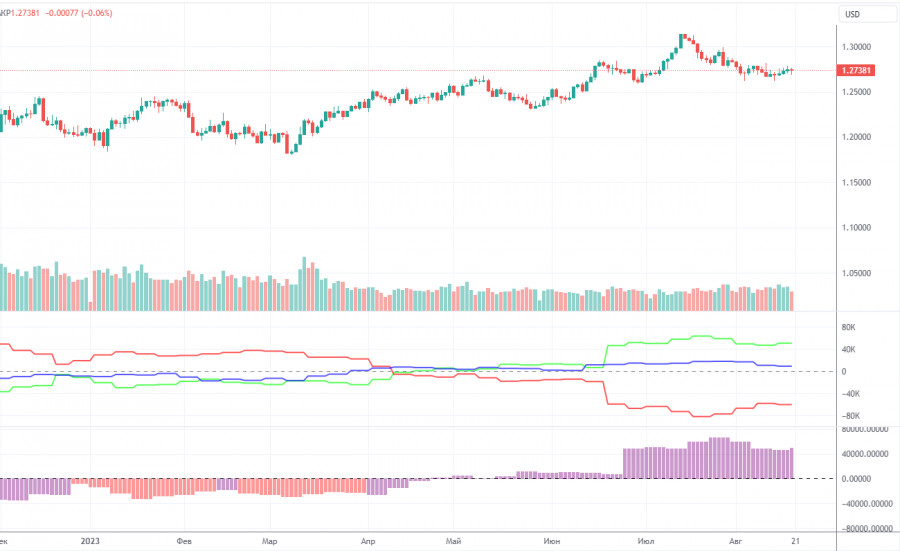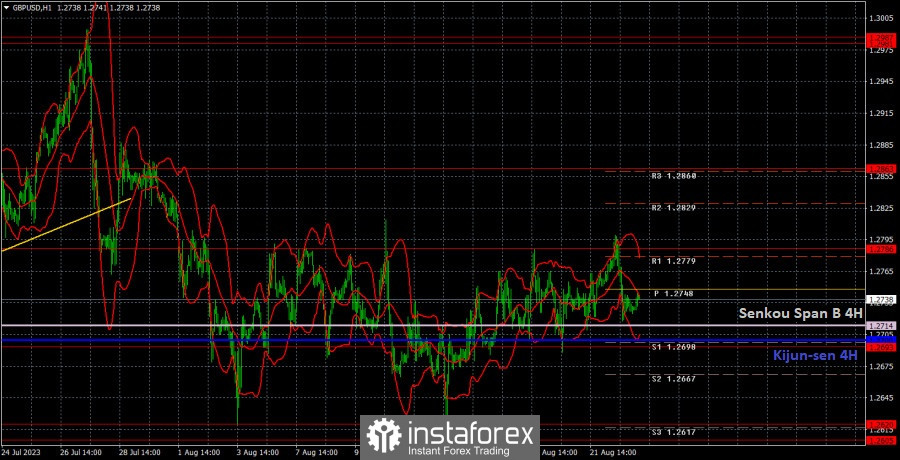

The GBP/USD pair continues to see a lot of sideways actions, which is clearly visible on the hourly chart. Given that the upper band of this channel (level 1.2786) was tested twice recently, it's no surprise that every rebound triggered a certain drop in the exchange rate. We expect the pound to fall in both the short- and medium-term periods. The bulls lack the necessary fundamental and macroeconomic support to pull the pair out of this consolidation, and yesterday showed us that the bears haven't gone anywhere but are just waiting for a convenient time to initiate a new sell-off. The only thing that is confusing now is the 24-hour chart, as the pair persistently fails to overcome the Ichimoku cloud.
There was only one trading signal on Tuesday. During the European session, the pair repeatedly tried to surpass the 1.2786 level, but above it was the Senkou Span B line (which we identified a few days earlier). As a result, this area prevented the pair from moving higher, leading to a significant drop. Traders should have opened short positions in this area since there was a good chance of a rebound. By the end of the day, the pound sterling had dropped at least 50 pips, which could have been captured by manually closing the short position towards the evening.
COT report:
According to the latest report, the non-commercial group of traders opened 7,300 long positions and 3,300 short ones. Thus, the net position of non-commercial traders increased by 4,000 positions in a week. The net position has been steadily growing over the past 11 months as well as the pound sterling. Now, the net position has advanced markedly. This is why the pair will hardly maintain its bullish momentum. I believe that a long and protracted downward movement should begin. COT reports signal a slight growth of the British currency but it will not be able to rise in the long term. There are no drivers for opening new long positions. Slowly, sell signals are emerging on the 4-hour and 24-hour charts.
The British currency has already grown by a total of 2,800 pips, from its absolute lows reached last year, which is a significant increase. Without a downward correction, the continuation of the uptrend will be illogical. However, there has been no logic in the pair's movements for quite some time. The market perceives the fundamental background one-sidedly, ignoring any data in favor of the dollar. The Non-commercial group of traders has a total of 90,500 long positions and 39,500 short ones. I remain skeptical about the long-term growth of the pound sterling, and the market has recently begun to pay attention to short positions.
Analysis of GBP/USD 1H
On the 1H chart, the pound/dollar pair proceeds within a sideways track; it has tried to break out of the channel but eventually failed. The lines of the Ichimoku indicator are currently weak, but from time to time they still work well with the market. Due to the flat phase, we identified the strongest values of the Senkou Span B and Kijun-sen lines, but false and inaccurate signals can still form around them. The pair tested the upper band of the channel on Thursday and Tuesday, so now we can expect the pound to fall. Consolidation above the Senkou Span B line will indicate that the pair has left the channel and it signals the possible start of a short-term uptrend.
On August 23, traders should pay attention to the following key levels: 1.2520, 1.2605-1.2620, 1.2693, 1.2786, 1.2863, 1.2981-1.2987, 1.3050. The Senkou Span B (1.2714) and Kijun-sen (1.2700) lines can also be sources of signals, e.g. rebounds and breakout of these levels and lines. It is recommended to set the Stop Loss orders at the breakeven level when the price moves in the right direction by 20 pips. The lines of the Ichimoku indicator can move during the day, which should be taken into account when determining trading signals. There are support and resistance levels that can be used to lock in profits.
On Wednesday, preliminary readings of UK and US PMIs for August will be released. The UK PMIs are more important, as the US pays more attention to the ISM PMIs.
Description of the chart:Support and resistance levels are thick red lines near which the trend may end. They do not provide trading signals;
The Kijun-sen and Senkou Span B lines are the lines of the Ichimoku indicator, plotted to the 1H timeframe from the 4H one. They provide trading signals;
Extreme levels are thin red lines from which the price bounced earlier. They provide trading signals;
Yellow lines are trend lines, trend channels, and any other technical patterns;
Indicator 1 on the COT charts is the net position size for each category of traders;
Indicator 2 on the COT charts is the net position size for the Non-commercial group.